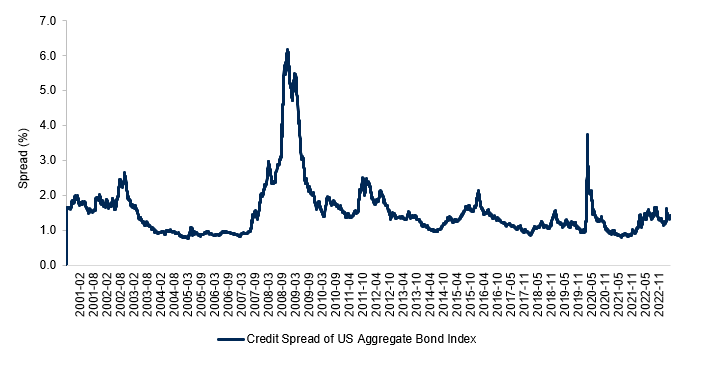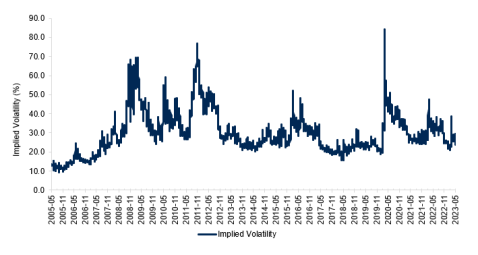SPONSORED CONTENT
From Meltdown to Meticulous: Decoding the drama of US Banking Crises

The banking crisis in March, although seemingly subdued, has raised concerns about potential systemic risks in the global banking sector, thereby fuelling speculation of an impending global recession. The gravity of this threat warrants a closer examination to determine its validity.
To assess the emergence of systemic weaknesses within the US banking system and the possibility of their contagion to the international financial landscape we employ the below graphs to serve as indicators to gauge the extent of risk containment achieved thus far. At Prescient Investment Management (PIM) we use an amalgamation of already existing inhouse indicators and a catered process to assess the contagion of the regional banking system.
To understand where we are going, we first need to understand where we were. The collapse of Silicon Valley Bank (SVB) and Signature Bank in March reverberated throughout stock markets, causing substantial disruptions. The occurrence of a bank run, wherein depositors simultaneously scramble to withdraw their funds, is exceedingly rare in the 21st century, especially within the United States. Thankfully, the Federal Reserve acted as a vital backstop during this critical juncture, ensuring stability and reassurance for account holders.
While legally bound to insure deposits surpassing the $250,000 threshold, the Federal Deposit Insurance Corporation (FDIC) swiftly intervened to safeguard all deposits at the distressed banks, injecting much-needed liquidity into the financial system. This proactive measure underscores the commitment of regulatory authorities to protect depositors’ interests and maintain the overall integrity of the banking sector.
In Europe, Credit Suisse’s exit from the financial landscape, following a series of scandals, culminated in its acquisition by UBS at a modest price of $3 billion. While Swiss authorities approved this transaction, it encountered shareholder dissent. This development rattled the European financial markets, particularly amidst the backdrop of a cost-of-living crisis, which has prompted experts to question the potentially adverse implications of escalating interest rates and mounting inflation on already heavily indebted consumers.
Fortunately, the banking sector in South Africa presents a contrasting picture, characterised by robustness and ample capitalisation. Similarly, in both the United States and Europe, there is presently no immediate cause for alarm. By employing a composed and analytical approach, it becomes evident why both SVB and Signature Bank experienced financial collapse. Notably, both institutions carried exceptionally high proportions of deposits that were uninsured by the FDIC, standing at over 94% and 89% respectively. Where the infamous book “Extraordinary Popular Delusions and the Madness of Crowds” by Charles Mackay published in 1841 consequently still holds true today- where individuals can be influenced by the emotions and actions of others, leading to irrational and sometimes even destructive behaviour- and as signs of distress emerged, clients swiftly withdrew significant sums of money in a thirst for liquidity.
The availability of comprehensive data published by the FDIC and a few other vendors serves as an invaluable tool for exposing inherent weaknesses within a financial system. We discuss a few of the indicators we use at Prescient to come to our weighted conclusion if this is an idiosyncratic event or if it has mutated into a systemic issue. As the data presently suggests. the risk of global financial contagion has been contained.
US credit spreads
To gain insights into the current situation, we can begin by examining the aggregate bond credit spreads in the United States. A bond credit spread represents the yield differential between a relatively risk-free US Treasury bond and a corporate bond with a similar maturity. Essentially, it quantifies the compensation demanded for lending funds to large corporations. Typically, during periods of financial uncertainty, such as the global financial crisis (GFC) in 2008, this spread exhibits an upward surge, reflecting heightened market apprehension. However, in the context of the recent mini-crisis, the graph reveals that the spread has not experienced a substantial spike. This observation suggests that, overall, US corporations are faring well in the current scenario.
Figure 1: US Aggregate Bond Credit Spreads

Sources: Prescient Investment Management, Bloomberg (as at 02 June 2023)
Funding pressure
A valuable indicator of default risk in the interbank sector is funding pressure, which gauges the level of perceived risk. The LIBOR-OIS spread, which represents the disparity between the three-month LIBOR rate and the Overnight Indexed Swap (OIS) rate. The spread could be understood by comparing it to the flow of water in a pipe system. In this analogy, the LIBOR rate represents the pressure of water in the pipe, while the OIS rate represents the baseline or standard pressure. The difference between the two rates, reflected in the LIBOR-OIS spread, signifies the additional pressure or strain on the system.
When there is funding pressure in the interbank sector, it’s like an increase in pressure within the pipe system. Just as increased pressure in the pipes can indicate potential blockages or stress on the system, a spike in the LIBOR-OIS spread suggests elevated risks and strains in the interbank lending market. Conversely, when funding pressure is low, it’s like a smooth flow of water in the pipes, indicating a more stable and healthier financial environment.
Figure 2: Funding Pressure

Sources: Prescient Investment Management, Bloomberg (as at 02 June 2023)
As illustrated in the provided graph, with the exception of significant surges during the GFC in 2008, the European debt crisis in 2010, and a slight disturbance in 2020 due to the COVID-19 pandemic, there is currently no imminent cause for alarm. Funding pressure, as evidenced by the spread, has remained relatively subdued. Therefore, there is little reason to panic, as the occurrence of significant funding pressure has been largely absent.
Implied volatility
Implied volatility could be compared to weather forecasts. Just as weather forecasts provide an estimation of future weather conditions based on various factors, implied volatility offers an estimate of future price movements based on market expectations and factors such as supply and demand. Similar to how a weather forecast predicts the likelihood of rain or storms, implied volatility indicates the perceived level of risk or volatility in the financial markets. Just as weather forecasts can impact outdoor plans and activities, implied volatility influences investment decisions, particularly those related to options pricing and risk management strategies. Higher implied volatility indicates a higher premium, reflecting increased market risk. Conversely, lower implied volatility suggests greater market confidence.
Figure 3: Implied Volatility

Sources: Prescient Investment Management, Bloomberg (as at 02 June 2023)
As depicted above, implied volatility remained largely unaffected during the recent bank failures in the US and Europe. This signifies isolated incidents rather than evidence of a systemic problem. Furthermore, the resilience of large banks to external shocks is reaffirmed by the data presented in the subsequent graph.
Large banks are still robust
For larger global banks, Credit Default Swaps (CDS) act as a form of insurance against debt default. CDS spreads represent the premium paid to transfer credit risk and provide protection to buyers in the event of a credit-related incident. Higher spreads indicate a greater risk of default. During periods of turmoil, these spreads typically rise. In the case of banks in general, CDS spreads have remained low. However, Credit Suisse experienced a significant increase in its spread, reaching approximately 10% prior to the UBS acquisition. This suggests that the risk was specific to Credit Suisse and not indicative of a broader contagion risk, as observed during the GFC in 2008 or the European debt crisis in 2010.
No crisis – yet
The prompt actions taken by the Federal Reserve and Swiss authorities effectively restored stability to both the US and European financial systems, yet lingering concerns persist. Chief among them is the vulnerability of the US banking system and the moral hazard inherent in the Federal Reserve’s backstopping of all bank deposits. Critics argue that this accommodative monetary policy may perpetuate a cycle of inflation and rising lending rates, as evidenced by the Federal Funds Rate’s climb of five percentage points in just one year.
Our analysis indicates that smaller regional banks in the US and Europe exhibit greater weaknesses. These banks tend to lend to riskier clients, thereby elevating the likelihood of defaults. This was evident in the cases of SVB and Signature Bank, both burdened by a significant proportion of uninsured deposits.
At present, we believe that large global banks are relatively secure. However, history has shown that sentiment can profoundly influence the fate of banks and during times of pressure, pipes may burst if weather conditions change. DM/BM
Authors: Bastian Teichgreeber, Chief Investment Officer at Prescient Investment Management & Adam De Waal, Quantitative Analyst at Prescient Investment Management.

Bastian Teichgreeber (left) and Adam De Waal (right)
Disclaimer:
- Prescient Investment Management (Pty) Ltd is an authorised financial services provider (FSP 612).
- The value of investments may go up as well as down, and past performance is not necessarily a guide to future performance.
- There are risks involved in buying or selling a financial product.
- There are representatives acting under supervision.
- This document is for information purposes only and does not constitute or form part of any offer to issue or sell or any solicitation of any offer to subscribe for or purchase any particular investments. Opinions expressed in this document may be changed without notice at any time after publication. We therefore disclaim any liability for any loss, liability, damage (whether direct or consequential) or expense of any nature whatsoever which may be suffered as a result of or which may be attributable directly or indirectly to the use of or reliance upon the information.
















